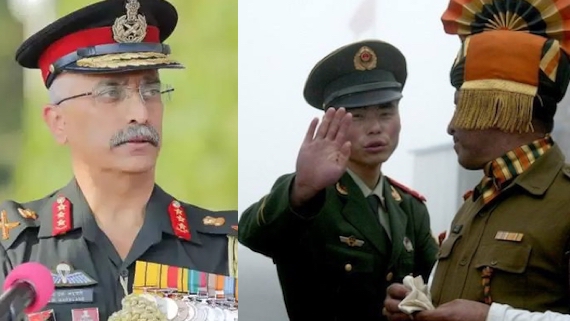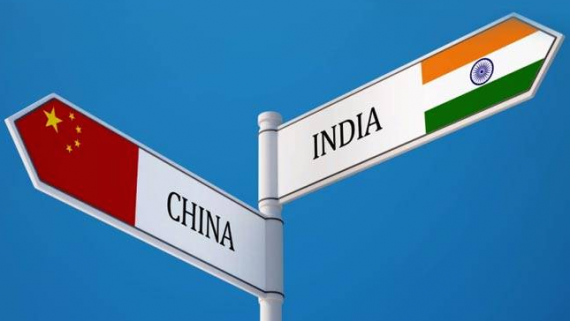Political News » World News
Tensions Mount Between China and India Amidst Fresh Flareup of Border Dispute in Ladakh Region [Special Report]
May 24, 2020 | By Sikh Siyasat Bureau
Border dispute between China and India in Ladakh region has flared up again. This has led to increase in border tensions between China and India.
PLA Increasing Troops at 3 Points:
There are reports that the People’s Liberation Army (PLA) of Chinese is fast increasing its troops in areas around Pangong Tso lake, Demchok and Galwan Valley along the Line of Actual Control in Ladakh region.
Reports in the media note that Chinese helicopter activist has seen a spurt in Ladakh.
Recent Clashes Between Chinese and Indian Troops:
Escalation in Eastern Ladakh led to clashes and hand to hand fighting between Chinese and Indian soldiers on May 5. Media reports say around 250 soldiers from both sides engaged in this fight at Pangong Tso and around 100 soldiers from both sides sustained injuries. Two sides reportedly agreed to “disengage” following a meeting at the level of local commanders.

Images used for representational purpose only
The incident in Pangong Tso was followed by a similar incident in North Sikkim on May 9. Nearly 150 Chinese and Indian military personnel were engaged in a May 9 near Naku La Pass in the Sikkim sector and at least 10 soldiers from both sides reportedly sustained injuries.
Doklam Stand-Off of 2017:
Notably, the troops of China and India were engaged in a 73-day stand-off in Doklam tri-junction in 2017.
Contesting Claims Over Border and Line of Actual Control:
The China-India border dispute covers overlapping claim lines over the 3,488-km-long Line of Actual Control (LAC) that has never been demarcated.
Differences at Around Two Dozen Spots over LAC:
Differing perceptions over control of areas are particularly acute in around two dozen spots across the Western (Ladakh), Middle (Himachal Pradesh and Uttarakhand), Sikkim, and Eastern (Arunachal Pradesh) sectors of the India-China border.

Image used for representational purpose only
The boundary in the Sikkim sector is broadly agreed, but has not been delineated.
Indian Army Chief Pays ‘Silent Visit’ to 14 Corps HQ in Ladakh:
Indian army chief General M M Naravane on Friday (May 23) made a quiet trip to Leh, the headquarters of the 14 Corps in Ladakh.
Media reports quote undisclosed sources saying that the visit was aimed at taking stock of the operational situation along the disputed Line of Actual Control amid rising tensions between China and India.
News reports have also noted that the Indian Army Chief’s visits are “usually well publicised” by the Army “but this time there has been no details or photographs that have been made public”.
A report on News18 website says: “Sources say Gen Naravane did not visit any forward areas but spent half a day speaking to Commanders at the 14 Corps HQ. He was accompanied by Northern Command Chief Lt Gen YK Joshi”.
Chinese Soldiers Enter in Areas Claimed by India:
A report in Times of India (ToI) notes that “[t]here were reports of multiple transgressions by Chinese troops in Eastern Ladakh region in the last one week. However, there is no official confirmation or reaction to it”.
ITBP Soldier Detained By Chinese Troops, Rifle Snatched, Returned:
Quoting undisclosed sources the NDTV has reported that [a]n Indian patrol party of the army and the Indo-Tibetan Border Police (ITBP) were detained and later released by Chinese forces after a scuffle between the two sides in Ladakh earlier this week.
According to NDTV a senior bureaucrat (name not mentioned) said: “[t]he situation became very volatile last Wednesday when a scuffle between Indian jawans and the Chinese resulted in detention of some of our jawans but later they were released”.
“According to him, in the scuffle, weapons of ITBP jawans were also snatched. But eventually weapons were handed back and our jawans also came back”, reads NDTV report.
The Road Connection:
It is believed that the muscle flexing by Chinese military is in response to a 255 km Darbuk-Shyok-DBO road that India built on its side of the border last year.
This road enables India’s access to the Depsang area and Galwan Valley while ending near the strategically important Karakoram Pass.
China Has Enjoyed Upper Hand in Pangong lake Area:
The northern bank of Pangong lake has been a point of contention where there are disputed perceptions of the LAC. The broader context for the tensions appears to be a changing dynamic along the LAC, as India is trying to raise its infrastructure there. China has enjoyed an advantage in infrastructure as well as terrain that is more favourable to mobilisation.
Chinese Posture:
A report on China’s official newspaper ‘Global Times’ says that the Chinese troops’ new move was in response to “India’s illegal trespassing incident along the border” which “demonstrates the strong determination of the Chinese People’s Liberation Army (PLA) to defend its sovereign territory”.
It further says that “India is merely seeking to divert its domestic attention and pressure since the COVID-19 pandemic impacted its economy”.
It further says that “China has a military advantage in the Galwan Valley region. So, the Indian military won’t escalate the incident”.
While quoting Hu Zhiyong, a research fellow at the Institute of International Relations of the Shanghai Academy of Social Sciences, the Global Times reports: “the Galwan Valley is not like Doklam because it is in the Aksai Chin region in southern Xinjiang of China, where the Chinese military has an advantage and mature infrastructure. So, if India escalates the friction, the Indian military force could pay a heavy price”.
Confrontation Likely to Last Long:
As per reports the Chinese military is fast increasing its troops in areas around Pangong Tso lake and Galwan Valley along the LAC in Ladakh. It is being seen as a clear signal that it was not ready to end its confrontation with the Indian Army anytime soon.
To Get Sikh Siyasat News Alerts via WhatsApp:
(1) Save Our WhatsApp Number 0091-855-606-7689 to your phone contacts; and
(2) Send us Your Name via WhatsApp. Click Here to Send WhatsApp Message Now.
Sikh Siyasat is on Telegram Now. Subscribe to our Telegram Channel
Related Topics: Indian Politics, Indian State, Indo-China Border Dispute, Indo-China Relations, Narendra Modi Led BJP Government in India (2019-2024)




